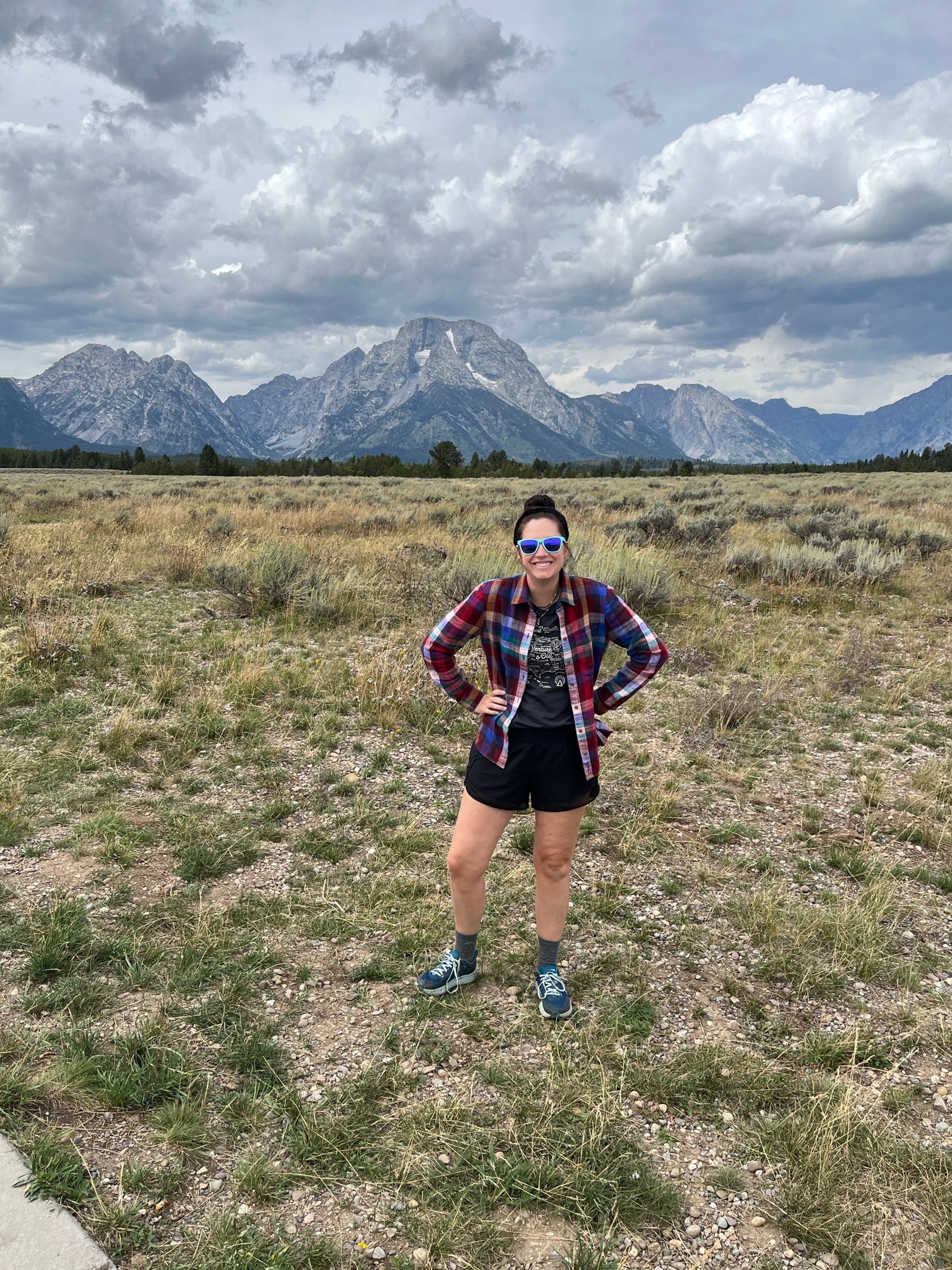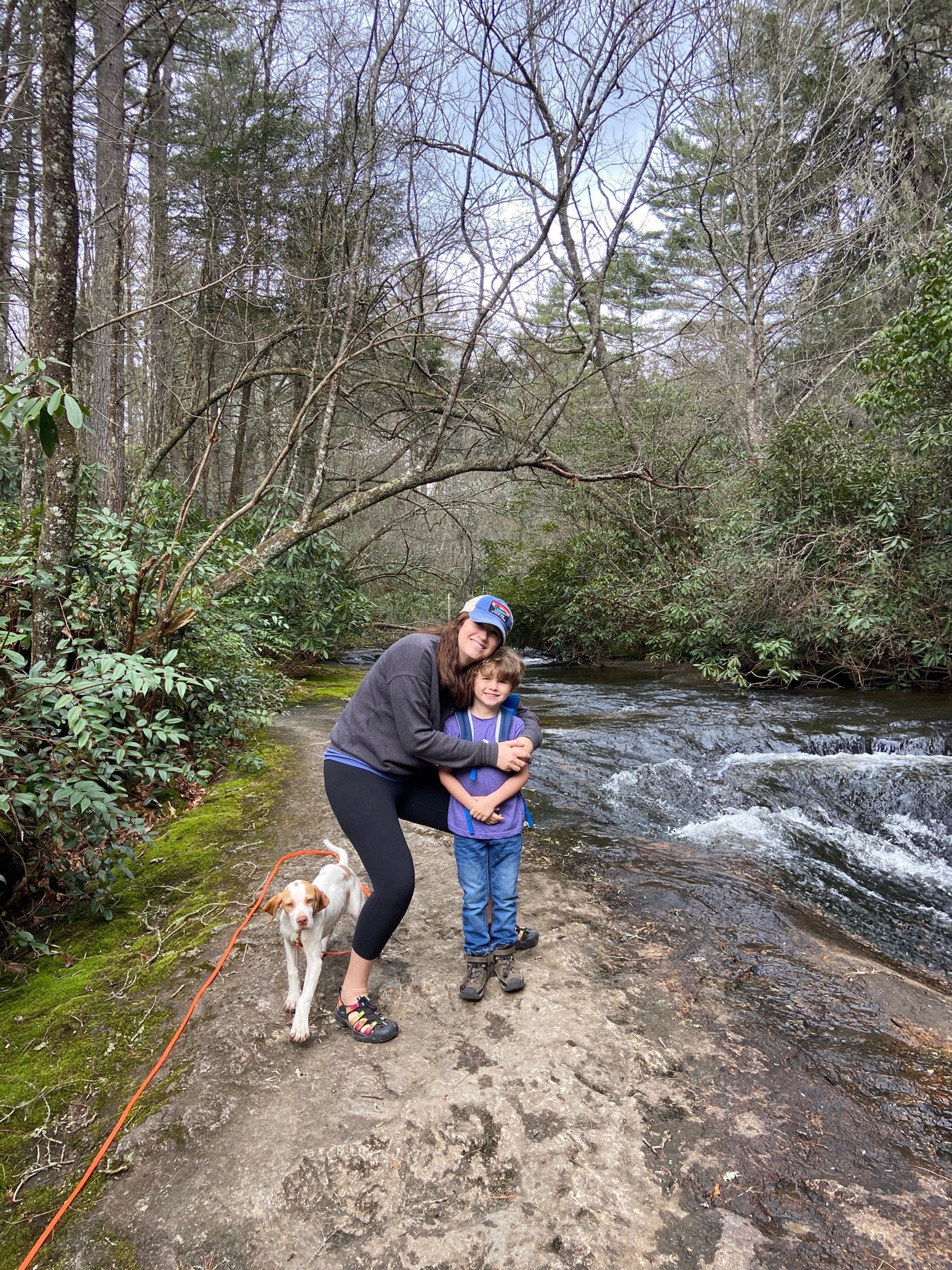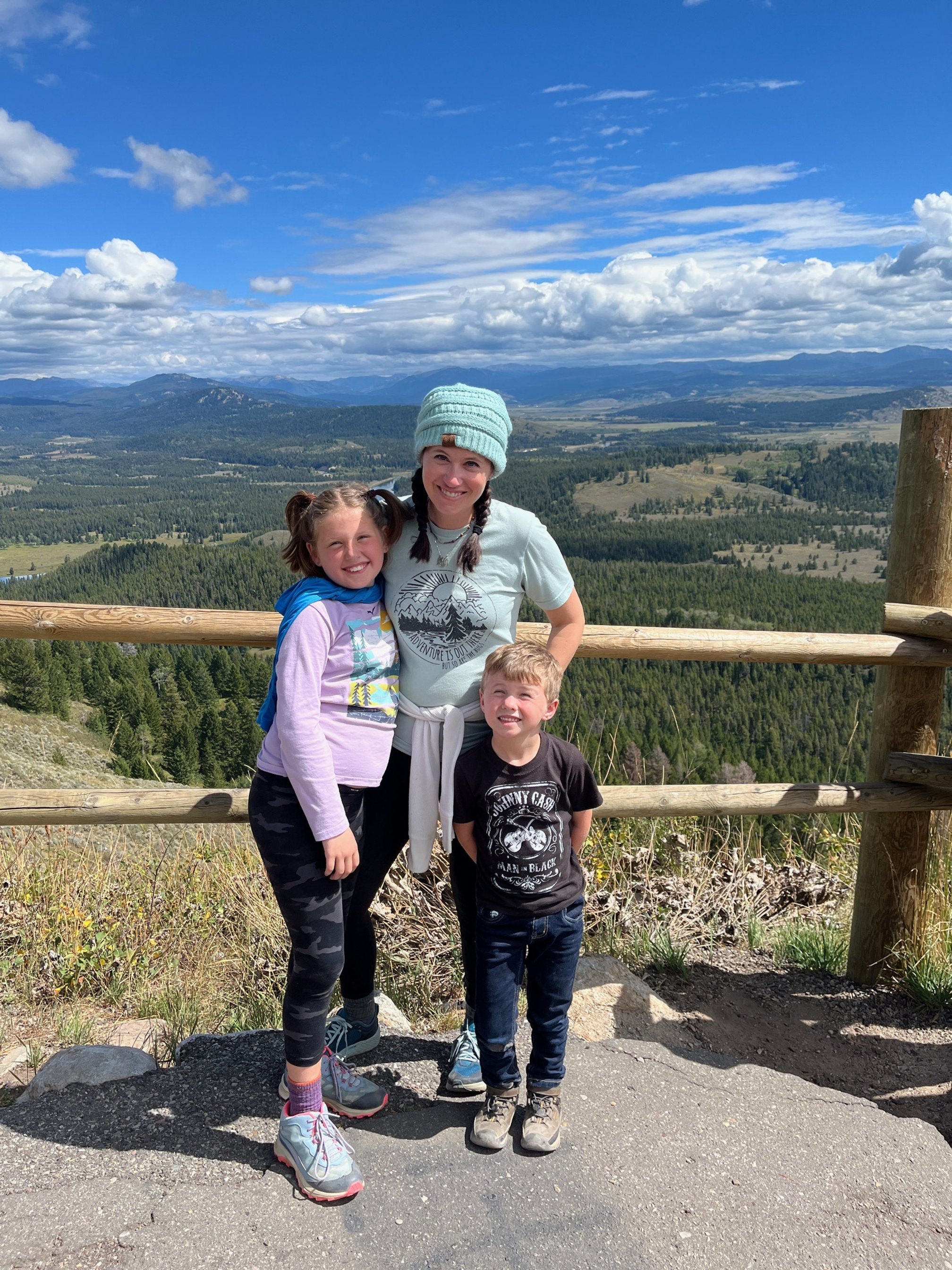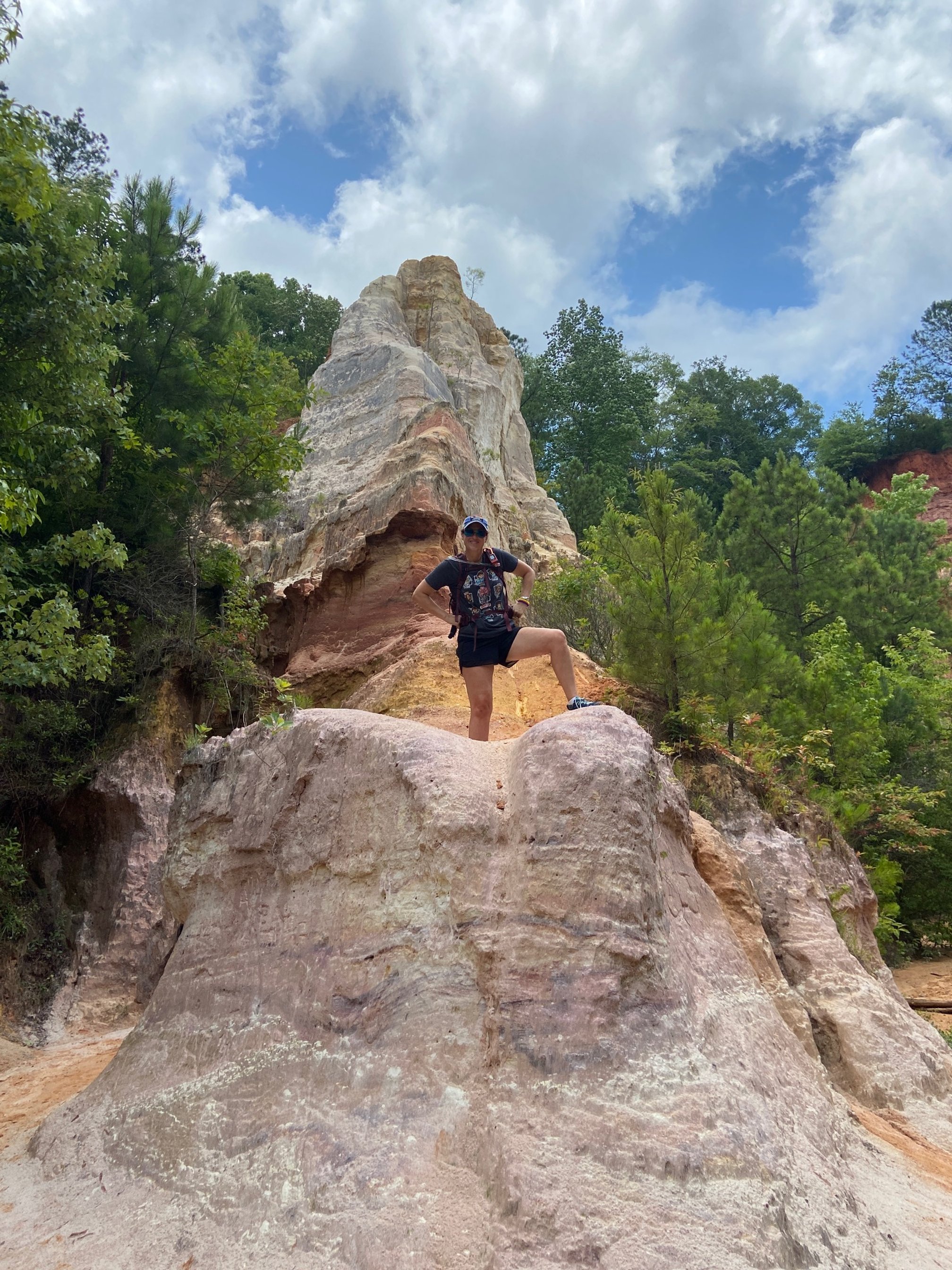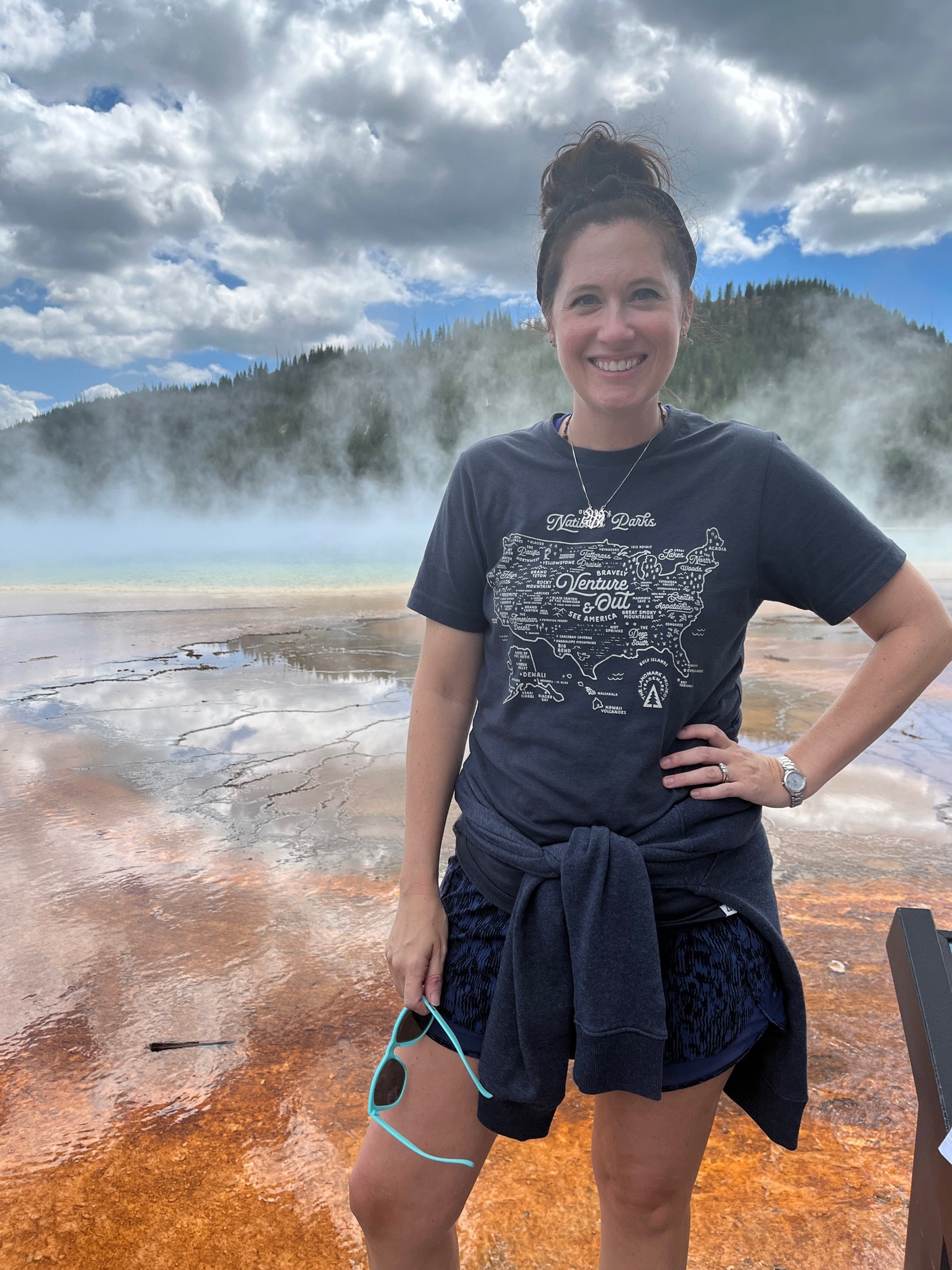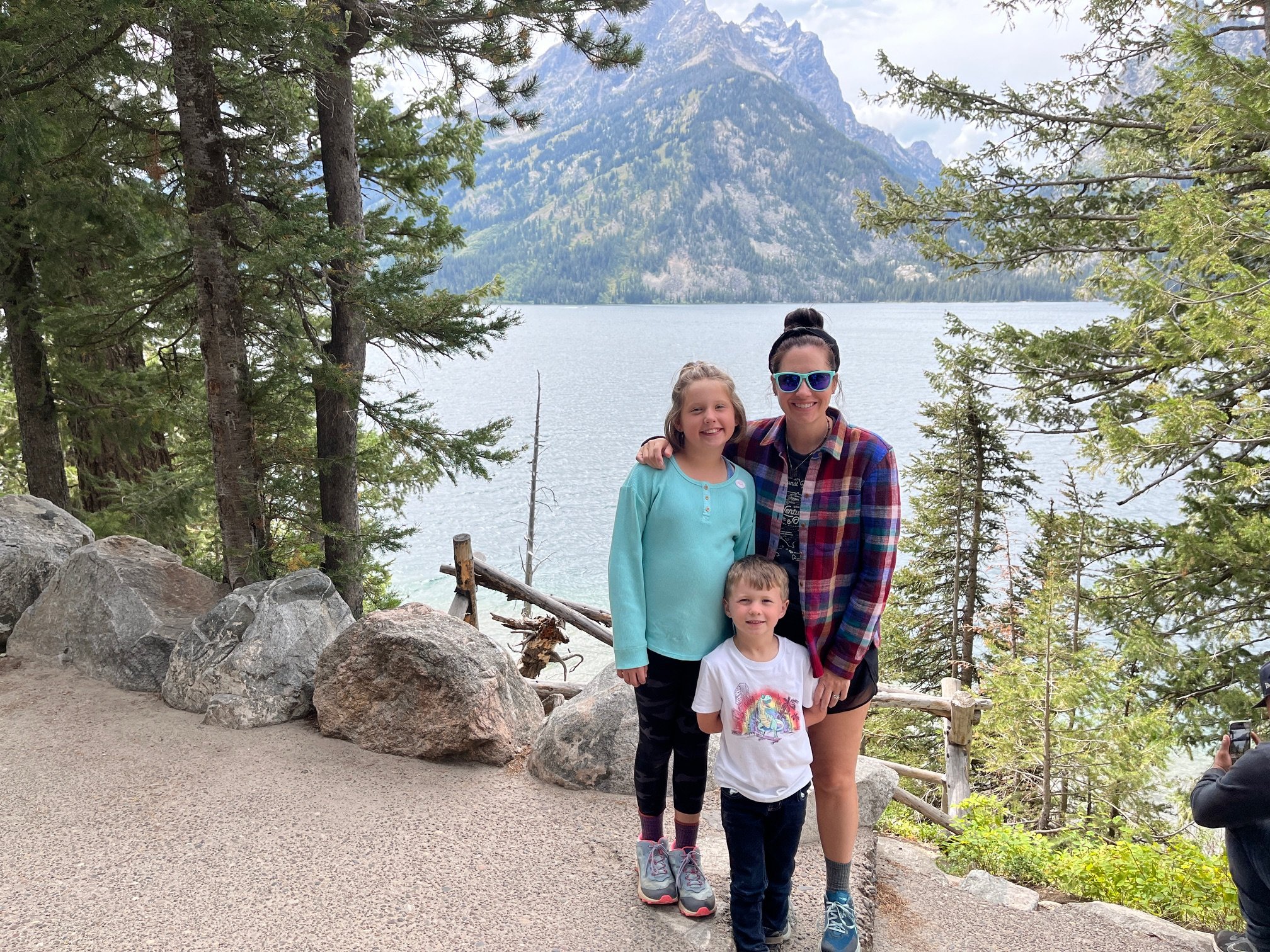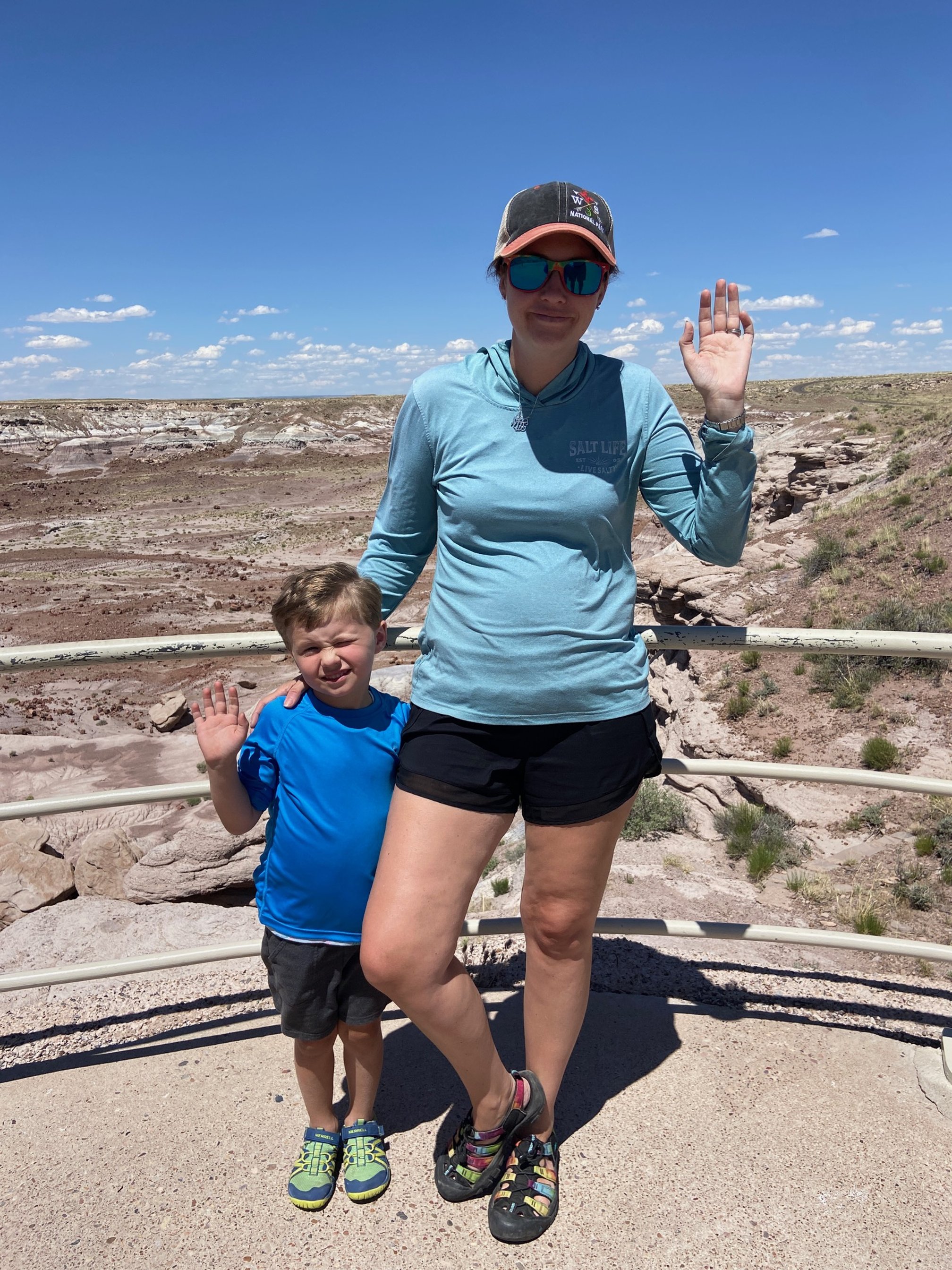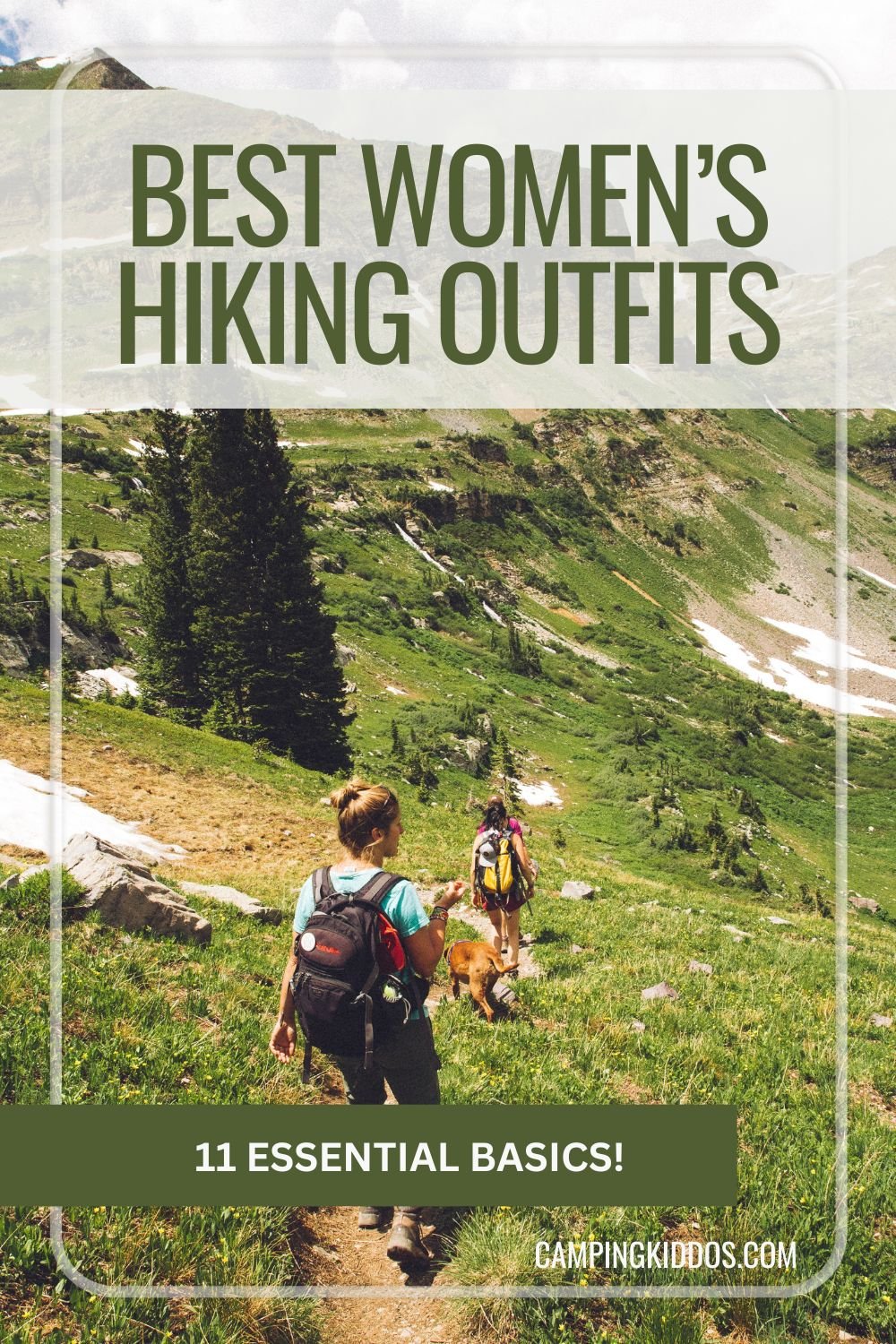Best Hiking Clothes for Women: Building a Capsule Wardrobe
Stay comfortable and stylish on the trail with the best hiking clothes for women!
From base layers to warm socks, I’ve rounded up my tried and true favorites for hiking below.
I’ve come a long way as a hiker since I first started—I think I wore jeans and a long sleeved t-shirt the first time I went hiking as a teenager.
While you can wear just about anything on the trail, you’ll be much more comfortable in appropriate layers, sweat wicking fabrics, and properly fitting shoes.
Over the years, I’ve slowly started building out my hiking wardrobe for both warm and cold weather hiking and camping, and this list is the product of my own trial and error.
I hope that you’ll discover a few new favorites that will make your own hiking experiences even better (and will make you feel cute while you’re at it)!
Heading out on a hike in Grand Teton National Park with my favorite hiking shorts and trail running shoes
This post contains affiliates. If you purchase through the links below, I will receive a commission at no charge to you.
Why Do Women Need Specific Hiking Clothes?
Simply put, a specially curated hiking wardrobe is made for your best performance on the trail.
And that means you’re more comfortable, which translates to you wanting to get out there even more!
I’ve advocated for essential kids hiking gear before on the blog since that fosters your kids’ desire to get outdoors. (Pick up the helpful kids hiking gear checklist here!)
So, why would it be any different for the moms out there?
Below, I’ve included my 11 favorite things to wear while I’m hiking.
I will worn you: proper hiking gear can be pricey, so don’t think you have to run out and buy all of these things at one time.
I tried to do that at REI last year, and I was shocked at how expensive good gear can be.
Even though I have all of this technical gear, you can still find me hiking in a cotton t-shirt some days because that’s all I packed or because we decided to do a quick hike while out running other errands.
Remember, any way that you can get out on the trail is the right way to hike!
This clothing gear haul is the icing on the cake, of course, and will help you regulate your temperature better, wick sweat faster, and quickly adapt to changing conditions.
Women’s Essential Hiking Clothes
When hiking, your wardrobe should be all about light, packable layers.
Since you’re outside, and the weather can change quickly, you’ll want to be able to add or shed layers to keep yourself protected from the elements without being too hot or too cold.
I know that it seems counterintuitive to layer 3 different shirts and jackets when you’re hiking in an obviously cool climate, but your body will heat up during the hike, and you will want to come out of some of that clothing before the hike is over.
By mixing and matching the 11 items below, you’ll have options for literally any hike, distance, and climate.
This capsule wardrobe also makes it easy to customize your outfit for your comfort level and be out on the trail in no time.
I am the furthest thing from a fashion influencer possible, so you’ll notice that my suggestions are all about practicality and comfort. Whenever possible, I’ve tried to include potential alternatives in a variety of price points.
You’ll also see that I practice what I preach in that I truly have compiled a hiking capsule wardrobe. I have several pieces that I love and wear over and over again.
Below, I’ve included photos of myself in these suggested pieces in Georgia, Virginia, Wyoming, Arizona, and New Mexico, and that’s just a fraction of the places I wear and re-wear these clothes!
Leggings
Full length leggings work in just about any hiking situation.
For summer, they protect my legs from briars, bug bites, and too much sun.
In the winter, they add warmth to my body and can be used as an additional base layer if I’m particularly cold.
Opt for leggings with a clingy fit all the way down—this isn’t the time to take your flared leggings/ yoga pants out for the day.
While the flared leggings are cute, they will pick up everything on the trail from bits of leaves to sharp thorns.
The tighter leggings with form fitting fabric also protect against ticks or other creepy crawlies.
If you prefer a cropped legging, that will work, too. Just keep an extra lookout for any briars or bugs that might want to attack your ankles.
While just about any high quality legging will do on the trail, you’ll want to look for a pair with moisture wicking fabric, a comfortable combination of stretch and compression, and flat seams.
I prefer the Ultra High Rise Elation Tights from Athleta since they’re long enough to be full length on me (I’m 5’7”). They’re super comfortable with just a bit of compression.
I also have a cropped version that fits just as well. Both are staples in my hiking wardrobe.
The fabric is so light that it’s easy to wear in summer, but it manages to be a great layer for hiking in colder weather, too.
On really chilly days, I’ve layered these with my favorite base layer leggings AND my recommended trail pants for the maximum coziness.
I’ve had the same pair of Athleta leggings for 3 years now, and they’re still going strong. They don’t pill (even with a bit of chub rub going on in the thigh area), and the stretchiness hasn’t diminished in the many, many wash cycles the leggings have been through.
If $100 leggings aren’t in the budget at the moment, the Dragon Fit Compression Leggings from Amazon are a pretty good dupe.
Exercise shorts
There are some days on the trail that it is just TOO hot to wear leggings, and this is where a great pair of exercise shorts comes into play.
Compare several different pairs of shorts to see which you prefer: you might like a well made pair of bike shorts, or you could find yourself feeling better in a pair of looser fitting running shorts.
I’m definitely in the running shorts group, as I like to feel as breezy as possible when hiking mid-summer here in the humid South.
Keep in mind that, no matter which style you choose, you’ll have more leg exposed during your hike than with leggings. In areas where ticks, chiggers, mosquitos, and other biting insects are a concern, be vigilant with extra bug spray.
My pick for best hiking shorts for hot weather is the High Rise Mesh Racer Run short from Athleta.
In fact, I love them so much that I have 4 pairs of the exact same shorts, and they’re what I wear pretty much all summer.
These are particularly great shorts for hiking since they are loose and lightweight, but also dry super fast.
I love the side pocket, which is just large enough to put my phone for quick pictures on the trail.
A good, cheaper dupe for these shorts are the Gym People Women’s High Waisted Running Shorts.
If you absolutely must have the Athleta shorts recommended, they do go on sale a couple of times throughout the year for around $35-40.
Sturdy Footwear
Footwear truly can make or break you on a trail.
Wearing my favorite trail running shoes at Jenny Lake in Grand Teton National Park
While it is tempting to use something you already have in your closet like tennis shoes, Crocs, or even flip flops, resist that urge.
Yes, speciality hiking shoes is an expense, but I’m a firm believer in taking care of your feet. (So much so that I have long advocated for proper hiking footwear for the entire family and even buying hiking shoes for toddlers!)
You really have 2 options here: hiking boots and trail running shoes.
Both have more support and better grip than a tennis shoe, and you’ll be able to hiker longer without foot pain. Plus, you’re less likely to get blisters with properly fitting hiking shoes.
Beyond that, it comes down to personal preference.
My husband and one of my children swear by hiking boots.
My older kid and I only wear trail running shoes.
My beloved Keen Newport H2 sandals at Petrified Forest National Park (my favorite hiking shorts and sun shirt also make an appearance!)
You’ll want to try on both to see how your foot, ankle, and arch feel in each.
I adore my Altra trail running shoes, which have a wide toe box and deep grooves for maximum traction.
These are my standard hiking shoes and I’ll wear them year round.
I also have a pair of Keen Newport H2 hiking sandals, which are amazing for hikes with water sections, or on days when the weather is really warm.
The Newport sandals over more coverage than a Chaco or Teva, which means my toes don’t get hurt as much on rocky trails.
Plus, the Keen Newport sandals come in a bunch of fun colors. I have the tie-dye pattern, which I love!
See more in the FAQs on the pros and cons of hiking boots vs. trail running shoes.
I don’t have a suggested dupe for my trail running or hiking sandals because this is one area where you get what you pay for.
That being said, if you’re strapped for cash and really want to get out on the trail, you’ll want to wear a well fitting pair of tennis shoes that has thick rubber soles and plenty of traction.
Base layers
For cold weather hiking (or if you’re perpetually freezing like me), you cannot sleep on buying base layers.
Base layers are essential! They form the backbone of your colder weather outdoor wardrobe as you build for specific weather conditions.
For example, when we were hiking in Natural Bridge State Park in Virginia in February, it was chilly.
I started with my base layer leggings and half zip long sleeved shirt, and then layered on a fleece jacket and down puffy jacket.
You might not need to go to that extreme since I’m extremely cold natured, but the base layers are excellent for keeping warm on the trail and by the campfire.
When we went hiking in Grand Teton National Park, the weather changed constantly and ranged from 30 to 75 in one day.
Having multiple layers—including those base layers—is crucial to keeping up with those kinds of changing temps.
My current go-to base layers are the synthetic base layers from REI. I have the REI Co-op Midweight Base Layer Tights and the Midweight Base Layer Half Zip top.
The base layer tights are misnamed as they’re nowhere near as fitted as the Athleta tights/leggings recommended above.
In fact, I have worn my Athleta leggings underneath my REI base layer tights without any issues.
The REI base layer top is comfy and made from the same material as the leggings.
I go back and forth on whether the half zip front was the right choice for me. The collar does add warmth when I zip it fully closed, but it adds bulk on days when I don’t need it zipped.
Plus, that high collar means I can’t layer it under a crew neck sweatshirt without it looking weird. (And no one wants that.)
In any case, the same shirt comes in both the half zip like I have and a crew neck version.
I didn’t get the wool base layers since they were at least $30 more per piece, and I was looking to build a hiking wardrobe without breaking the budget.
Since then, I’ve purchased several other hiking pieces in wool, and I am fully convinced of the power of wool when exercising.
This isn’t to say that my synthetic pieces are a bad choice—far from it!—just that wool has added benefits that I’d like to incorporate into my hiking wardrobe in the future.
See the FAQs section at the end of the post for more information on wool vs. synthetic base layers.
Wool t-shirt
For an entry level piece of wool clothing, there’s no better place to start than with a wool t-shirt.
I am obsessed with my Wool& Morgan t-shirt, which has a v-neck and comes in a half dozen colors. I currently have the iris blue and black, which work for SO many situations.
I wear these to the gym, on the trail, to dinner, and elsewhere on our travels.
I can wear them literally for days on end without them smelling or wrinkling.
If they do get something on them, I can quickly rinse them in the sink with a tiny bit of Dawn soap, roll out most of the moisture in a towel, and then hang to dry. By the next morning, they’re dry and ready to go again!
For overnight or longer backpacking trips, these wool shirts are a must have.
The wool shirts are also great for temperature regulation, somehow being cool on warm days, and warm on chillier days.
For that reason, they are a great option for a light base layer when it might be too warm for the long sleeved top recommended in the section above—but you still want to layer a sweatshirt or light jacket on top of what you’ll spend most of the day in.
Wool can be quite expensive, which is why this shirt has been one of my most recent additions to my hiking wardrobe (it took me SO long to get over the idea of a $70 t-shirt!).
That being said, you’ll be fine in a regular tank top or cotton t-shirt for a day out, despite what other outdoor and fitness influencers tell you.
I love my wool t-shirt, but I also wear a LOT of non-wool while I’m out adventuring. (Just look through the other pictures on this post to see evidence of that!)
Moisture Wicking Socks
Not all socks are created equal.
And when you’re hiking, your feet need to be pampered.
This means buying extra comfy socks that are going to keep your feet dry and protected throughout your hike.
Ditch the cheap athletic socks from those big box stores and opt for a pair of Darn Tough women’s socks instead.
The Darn Tough socks are a wool-nylon-Lycra blend, so they’re not itchy, soft, and a great barrier between your foot and hiking shoe.
Plus, they have a little bit of padding on the sole for added comfort on your feet.
I have had 1 pair of these for years, and they are still going strong!
The Darn Tough socks are so nice that I’ve added another 2 pairs, which are always packed for every camping and hiking trip I take.
Down Jacket
For those chilly mornings, nights around the campfire, and mid-winter hikes, a down jacket is a great piece to have.
I have a puffer down jacket that is super warm and great for layering.
Wearing my puffer jacket, Outdoor Afro x REI hiking pants and Altra trail running shoes at Natural Bridge State Park in Virginia
Plus, it’s incredibly lightweight, so when I get hot and need to shed that layer, the jacket doesn’t add but a tiny bit of weight to my pack.
There are so many variations on this jacket for every budget and warmth level.
You’ll want to do some research on down jacket fills and weights to determine what’s best for your typical hiking temperatures and climate.
You can also opt for a hooded jacket or one without, depending on your personal preference.
All of the major outdoor brands—Patagonia, North Face, REI, Cotopaxi, etc.—are going to have variations on this jacket with a huge range of pricing.
The higher the level of down fill, the more expensive that the jacket will be.
And the more down you have, the warmer that jacket will be.
We hike in the South year round where it never gets super cold, so I opted for the REI Co-op 650 Women’s Down Jacket.
It’s been an excellent choice for those just above freezing nights at the camper and cold early mornings on the trail around here from December into March.
I did have to size up to accommodate the 1-2 layers that I typically wear underneath the jacket.
Full Length Hiking Pants
Another great option for your capsule hiking wardrobe is a pair of full length hiking pants for women.
These are more durable than a pair of leggings, and they’re looser. This means that you can add a base layer and leggings underneath for a cold weather hike, or wear alone for a comfortable hike in the spring or fall.
I also love that hiking pants usually have ALL the pockets, so I can stash my phone, small snacks, and those rocks that my kids continually hand me (“but these rocks are special, Mom!”).
Most have technical features such as quick dry fabric, toggle waistbands for a custom fit, the ability to cinch in the leg bottoms to create joggers, and interior pockets for keys or credit cards.
Some are even convertible from pants to shorts for a quick change on the trail.
If you have as many issues finding pants that fit as I do, you’ll want to try on a wide range of hiking pants to see which ones are the most flattering while also being the most comfortable.
I currently have 2 go-to pairs of hiking pants, one from REI and the other from Kühl.
After asking an REI employee at least a thousand questions about their women’s hiking pant options, I settled on the Outdoor Afro x REI trail pants.
These hiking pants are great for women who have an hourglass or pear shape as the waist is much smaller than the hip area.
They have a ton of pockets, a zipper for added flair at the ankles, and a generous cut in the bottom and legs.
I did have to size up to find the right ratio of waist to hip comfort, and they now fit as if they were made for me.
I’m 5’7’, and the pants have a midrise on me, hitting right below my belly button. The pant legs skim the tops of my hiking shoes, so keep that in mind if you’re shorter than I am.
The pants came with super long pull tabs, which annoyed me when I was walking. I cut them off about halfway up the tab, and they are much more manageable now.
Other than that, the Outdoor Voices pants have been great to me, and I’ve worn them in multiple states and national parks.
As a bonus, they’re quick dry, resist wrinkling in my suitcase, and are lightweight.
The Kuhl women’s hiking pants are quickly overtaking my REI pants are the ones I reach for, though! The Kuhl Freeflex Move pants are made of this almost silky, quick dry material that is loose and comfy enough to wear as normal pants.
Plus, I’ve found that the waistband of the Kuhl pants are more comfortable than the Outdoor Voices x. REI pants. While I’m not getting rid of the Outdoor Voices pants, I do think I will get a second pair of the Kuhl pants before I rebought the REI ones.
Fleece Jacket
Another staple in my hiking wardrobe is a fleece jacket.
It’s an easy layer to throw on top of a wool shirt or tank in the morning, or pile onto a long sleeved base layer when the wind picks up on the trail.
I actually wear mine on and off the trail since it’s so comfortable, and it goes with everything from jeans to leggings. I’m actually wearing it while writing this piece!
Much like the down jacket (above), I sized up to accommodate base layers and to give myself additional room for movement while hiking.
These types of jackets are made by all of the major outdoor clothing companies, and much of your decision comes down to which design and color combination you like.
(Or, in my case, which are on sale because I’m cheap.)
I LOVE the colorful look of the Cotopaxi jackets, but I haven’t been able to pull the trigger on buying on yet. They’re expensive, but so pretty.
Wearing my fleece jacket at Thomas Dambo’s Mama Mimi statue at Rendezvous Park in Moose, Wyoming
Instead, I opted for one by The North Face, which has a snap front, elastic sleeve edging and a color block look.
The North Face Women’s Alpine Polartec 100 has a half snap closure, which is great for customizing how warm you need your neck to be.
The sleeves come to about halfway down my hands, which means that I don’t have any gaps on my wrists when I need to add gloves.
There’s an elastic band at the bottom of the jacket, too, which cuts down on the amount of wind or cold that will creep in.
Long Sleeved Sun Shirt
When we’re desert hiking, we all wear long sleeved sun shirts.
My sun shirt was essential at White Sands National Park
These are great protection against the sun and wind in this exposed environment, and it means that I don’t have to worry about sunscreen constantly. (We still use sunscreen on our hands, faces, and legs, though!)
The fabric on a sun shirt is also excellent at keeping me cool, which seems counterintuitive, doesn’t it?
I find that I’m more comfortable hiking for miles in the desert with that extra bit of protection on my arms and shoulders than I am with just a tank top or loose t-shirt.
Plus, the sun shirt gives me a full layer between my pack and my skin so I’m less likely to get any abrasions from my day pack straps rubbing on my often sweaty shoulders.
I have an aqua long sleeved Salt Life hoodie sun shirt that I got 4 years ago.
Since then, I’ve worn it hiking in Petrified Forest National Park with our kids, off shore fishing in Florida, boating here in South Carolina, and everywhere in between.
It has thumb holes, which I love as it helps protect my hands, and a longer torso length.
Weather Appropriate Hat
Last but not least, you’ll want a hat or two to finish off your capsule hiking wardrobe.
I have a collection of baseball hats that I use for sun protection during the warmer months.
I also have a CC beanie that I pull out every winter when we’re camping and hiking in Upstate South Carolina, North Carolina, and beyond.
I’d encourage you to have both a warm and cold weather hat to ensure that you’re trail ready no matter the season!
Women’s Hiking Clothes FAQs
If I can only start with one item on this list, what should it be?
I’d suggest starting with proper hiking shoes or boots as your feet are of utmost importance when you’re hiking.
If you have properly fitting and supportive hiking shoes, you can get away with a basic t-shirt and shorts combo until you’re ready to expand your wardrobe.
Another easy (and fairly inexpensive) addition to your starting hiking wardrobe is a pair of Darn Tough socks.
Those socks and a good pair of hiking shoes will have you comfortably on the trail in no time.
Should I pick wool or synthetic base layers?
I have both wool and synthetic clothing, and each has its own pros and cons.
PIN ME!
My first pair of hiking base layers was a polyester-spandex blend, which is considerably less expensive than merino wool.
I also have wool shirts and a wool dress that are in heavy rotation, so I can compare the two fabrics.
NOTE: If you’re interesting in learning more about hiking in a dress, check out my complete guide!
The synthetic fabric does a great job at keeping me warm, though it tends to need more frequent washing than the wool layers.
Wool is a powerhouse fabric—I can wear a piece of wool clothing all day, multiple days in a row, even in high temperatures, and it doesn’t stink.
While it isn’t hiking, I did go to Legoland with my kids and took only 1 wool shirt, which I wore 3 days in a row in 85 degree weather.
It stayed fresh the entire time.
If you’re car camping and hiking for a day or two, synthetic layers are going to be fine.
If you’re doing something more intensive or longer, you’ll want to pay extra for the wool.
What do I need if it rains?
You’ll notice that I don’t have a recommended hiking rain jacket on this list and that’s for a simple reason.
I don’t have one on purpose.
I’m based in the U.S. South which is moderately dry. If there’s rain forecasted, I just don’t go hiking—or, if it rains after 'I’m on the trail, I pull out our thin, reusable rain ponchos that the kids and I keep on our hiking packs at all time.
Our rain storms typically pass quickly, so we shake out the ponchos post-rain shower, let them dry on the front of our packs, and then stuff them back into their carriers.
Plus, these reusable ponchos are cheap, which is a bonus if you’re just getting your hiking gear together.
We’ve hiked in other areas of the country, including the Southwest, Midwest, and Mountain West regions, and this method has worked well.
That being said, I do plan on testing out some lightweight women’s rain jackets in the future in anticipation for our travels in the Pacific Northwest, New England, and Canada.
What’s better: trail running shoes or hiking boots?
This choice comes down to personal opinion.
I’ve tried both, and I just can’t get on board with hiking boots.
My ankles feel as if they’re being strangled, and I don’t like the lack of movement that comes along with the higher boots.
Instead, I’ve opted for trail running shoes (and share that suggestion above) since my ankles can breathe and I have a larger range of movement.
I had another woman tell me that she did the entire Pacific Crest Trail with my same trail running shoes, so it really comes down to what makes you feel the best.
Some hikers will say that hiking boots provide more ankle support while others say that the high support on a hiking boot actually weakens the ankle muscles over time since you’re not engaging them.
Y’all, I’m an English professor, not a physiology professor, so I can’t speak to the whole muscle weakness thing.
Pick the style of shoe that makes you feel the most likely to get out on the trail in comfort.
What should I wear for undergarments while hiking?
You’ll want to choose well fitting, comfortable undergarments with plenty of support. I rotate through a handful of tried and true sports bras while I’m hiking, but you can go with whatever makes you feel the best.
Remember, the more movement that any part of your body/skin is doing, the higher the likelihood that you’ll end up with chaffing, soreness, or pain.
If you’re particularly well endowed in the chest, you’ll want to find a sports bra that is supportive and limits movement.
I’ve had other female hikers swear by merino wool undergarments, but I haven’t had a chance to try those out yet. I’ll update when I do.

